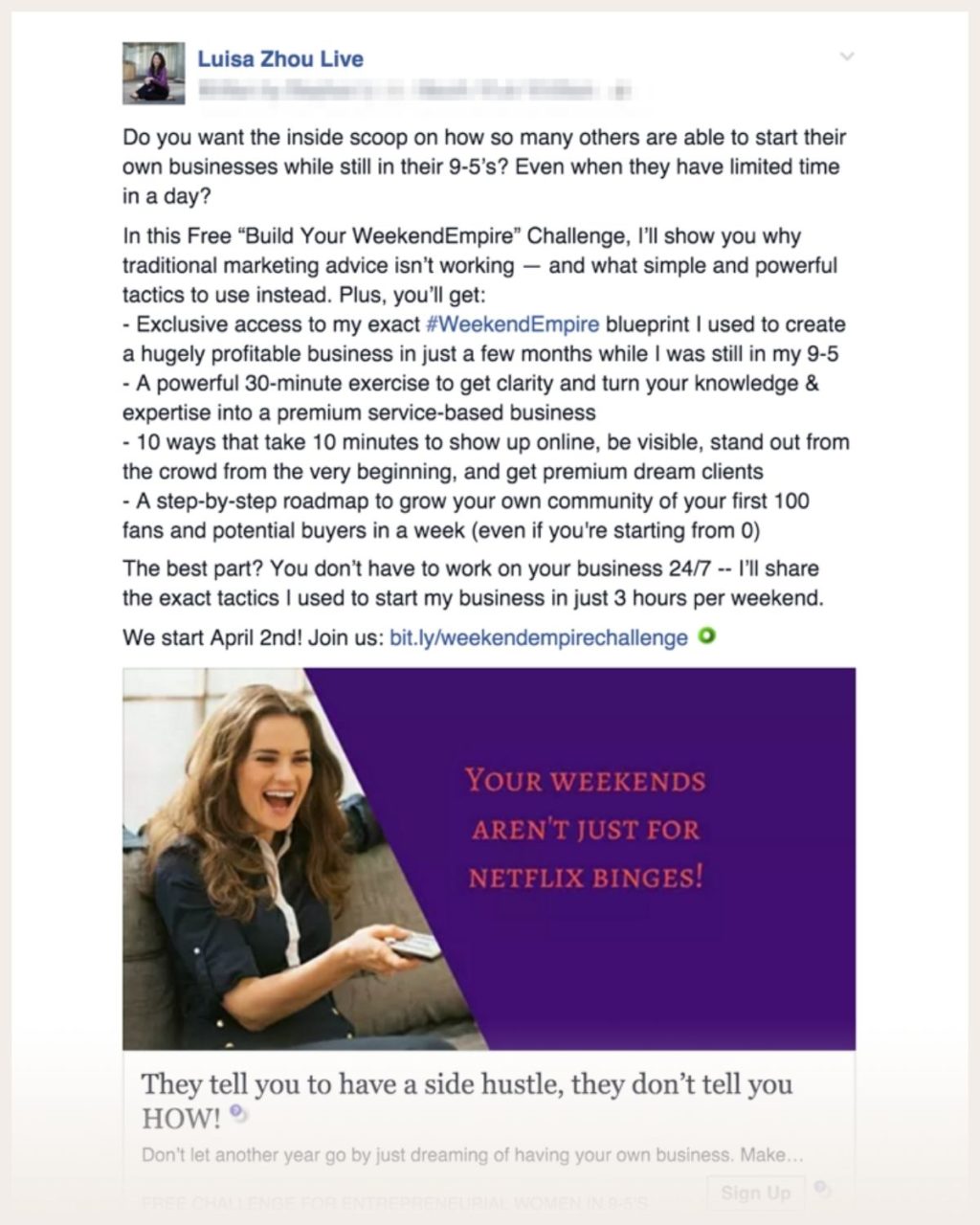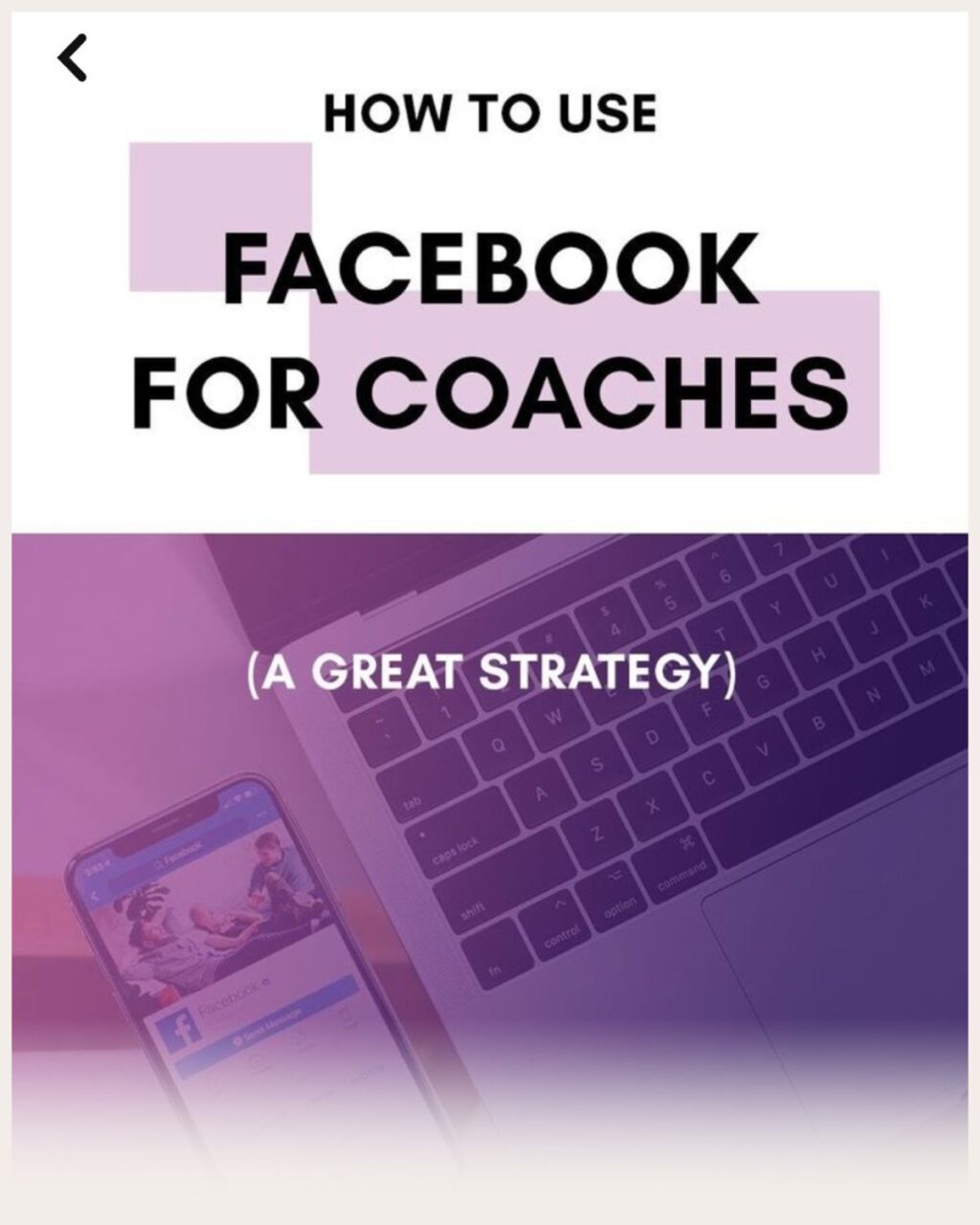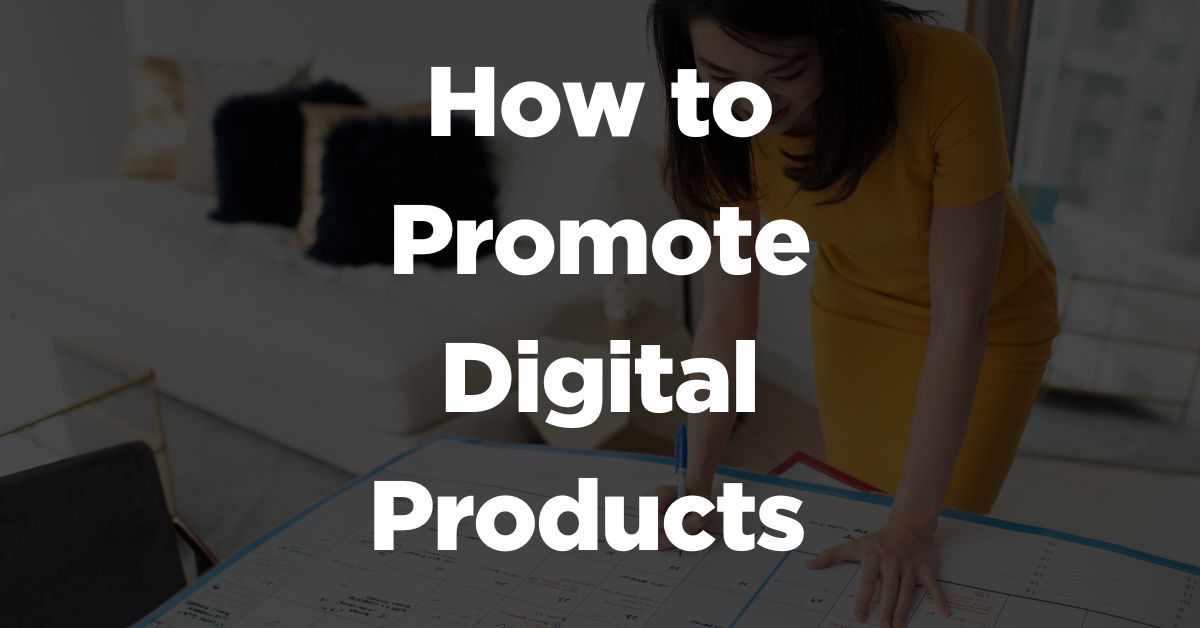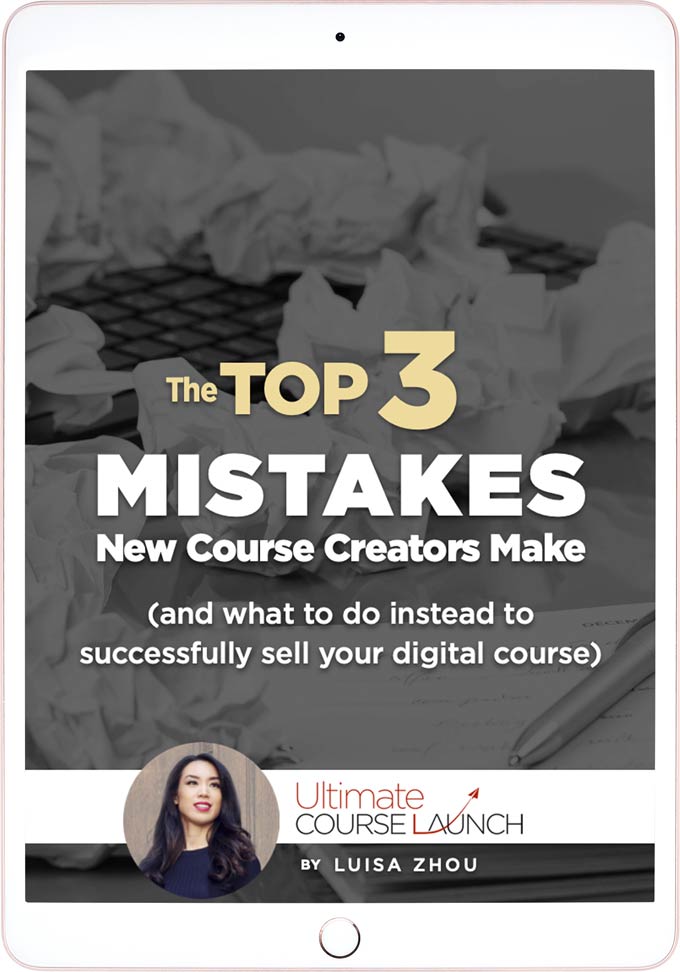Want to build a massively profitable digital product business?
Then, you need to know how to market them.
And today, you’ll learn exactly how to promote your digital products – and build a successful online business. (With the steps I’ve learned from having helped hundreds of creators build their own businesses.)
Want to learn more? Read on.
Top 10 digital product marketing strategies
Here are the best ways to market your digital product:
- Decide where to sell your digital products
- Build an audience
- Launch your product
- Use testimonials
- Get affiliates to market your product
- Get interviewed on podcasts
- Build your SEO
- Use paid ads
- Market on Pinterest
- Use organic social media
In a later section, we’ll go through each of these strategies in detail.
But for now, let’s look at what digital products are.
What is a digital product?
A digital product is a piece of online content you can buy or sell.
Some digital product ideas include:
- eBooks
- Stock photos/video/audio
- Mobile apps
- Software templates (such as Notion templates, WordPress templates, or Procreate brushes)
- PDF guides
- Digital art/NFTs
- Membership site
- Online courses
Here, we’ll talk mostly about how to sell online courses. But the promotion strategies can apply to any digital product.
(Why focus on online courses? Because an online course is the most profitable digital product you can create with the least amount of effort.)
What are the benefits of selling digital products?
Selling digital products has many benefits.
They are:
- Profitability: Digital products can be highly profitable because of repeat revenue. And online courses are the most profitable of them all. The industry will be worth over $200 billion by 2024. For instance, in comparison with physical products, digital products come with far less production, shipping, and other costs.
- “Passive” income: Look, passive income doesn’t really exist. You always have to put in a little work to make money. But digital products are the closest you’re going to get. Once you’ve created the product, you can keep selling it for years to come. In comparison, with an online course, you need to buy in stock, which creates extra costs.
- Flexibility: Creating the product can be time-consuming in the beginning. But after that, you can spend LESS time working to make consistent sales in your business. With the right sales funnel, your sales process can be even simpler.
- Scalability: Creating a digital product gives you the opportunity for repeated sales. And repeated sales help you scale your business. Now you just need to market the product to make a profit.
So if you’re ready to create freedom and profit in your business with an online course or digital product, let’s talk about how to promote digital products.
How do you promote digital products?
We’re about to look at the top ten marketing strategies for promoting a digital product.
But let’s get one thing clear – you shouldn’t to use ALL of them.
Pick one or two strategies to make your first few sales, then add to your marketing strategy later. If you try to do everything at once, you’ll stretch yourself thin.
Not sure where to start? This video will help you figure out which is the best method for you:
Keep that checklist in mind as you read about each strategy.
1. Decide where to sell your digital products
Figuring out where you’re going to sell your digital products is the first essential step.
You have three options:
- Your own website: Selling digital products from your website requires more maintenance from you. But it’s not overly complicated. If you have a WordPress website, you can use a plugin like AccessAlly to create and run courses.
- A marketplace: There are marketplaces for every type of digital product. For courses, you’ve got Udemy, Skillshare, Gumroad, and so on. These are easy to use and you tap into an existing audience, but you don’t own your audience. You also have to follow their pricing guidelines. Or you might get a revenue share (Skillshare works this way).
- A digital product/course platform: Platforms like Teachable allow you to make, sell, and market digital products all in one place. I recommend Teachable for selling courses because it’s intuitive with great sales funnel capabilities.
After you’ve chosen where you’re going to sell your digital product, it’s time to move on to the second essential marketing step.
That is…
2. Build an audience
Look, you need an audience to sell your product to.
Practically speaking, how do you build an audience?
First, you need a platform. The best social media platform for your business will depend on your niche and your audience.
For example, if you’re selling a course for new executives, LinkedIn might be the right place for you.
My student Julie Kim helps high school students get into top universities. So she might want to market her course on Instagram or TikTok. These platforms have younger audiences.
Now, contrary to popular belief (and what most “gurus” tell you), you don’t need a massive audience to make money.
You can build your audience as you launch your product.
To do that, use your course launch to capture the attention of strangers and turn them into customers.
Here’s how:
- Emphasize the gap between what you know and what your customers want to know so that they’re excited to buy
- Amplify personal connections to build rapport with your potential customers
- Give “Step Zero” wins to your audience to build trust
That last step, you can achieve with a launch event. Let’s talk about that next.
3. Hold a launch event
A launch event is something that draws your clients to the launch of your product.
Think free webinar, mini-email coaching course, or online challenges.
This is the strategy I used for my first launches.
I did a live challenge on Facebook. Participants followed daily prompts over five days to help them get their first paying clients.
Because it was a challenge that would give them a “win” (AKA a “Step Zero” win), it attracted more potential customers to my page.
And it worked. Even though I had a small list, this strategy led to over $8k in sales.
Not bad for a first launch.

So what value can you offer to potential customers to grow your audience?
For example, if you’re a career coach, you could lead a live challenge that gives daily advice on how to craft a compelling resume.
Whatever you choose, it needs to create a result and be exciting to new audience members.
4. Get testimonials
Want potential customers to invest in your digital product? You need to build trust.
Testimonials build that trust. In fact, 77% of people say reputation and online reviews are important deciding factors when they want to buy.
You can get testimonials from a range of sources. And not just from paying clients.
Consider this:
Ask your network
If you’ve helped friends and family achieve goals related to your niche, ask them for a written or public testimonial.
I did this when I first started as a career coach. Some of my friends had gotten raises from the advice I gave them. So they were happy to give me a testimonial as social proof when I needed it.
Provide free services
If you haven’t worked with any clients or your network yet, reach out to potential clients and offer services for free.
But don’t offer just any service for free. And don’t offer a “beta” version of your course.
Instead, provide the smallest possible project that will get your client results without taking up too much of your time.
Reach out to existing clients
If you already have paid clients who can vouch for your work, reach out for positive feedback.
You want to approach them at the end of your time working together. Or after they’ve achieved a significant result toward their goal.
This also works for people who have used your digital product before. You can encourage them to leave a review on the platform you’re using to host the product. Or ask for direct email testimonials you can display on social media.
So that’s where to get a testimonial. But what makes a good testimonial?
Ask the client the following questions:
“What transformation did you go through while working together? How does that compare to where you started?”
“Were you happy with the experience of working with me? What was it like?”
“What results did you achieve as a result of working together? Get specific.”
“Would you recommend my services to a friend? What would you tell them about working with me?”
However, former clients and people in your network are not just people you can ask for testimonials – they might also be great candidates for affiliate marketing.
Read on to learn how it works.
5. Use affiliate marketing
Affiliate marketing or influencer marketing is when people with existing audiences promote your product and get a commission.
Often, the commission is between 25-50% of the product price depending on the type of product.
Working with influencers of any size can boost your brand awareness, increase traffic to your platform, and grow sales.
To find the right affiliates for your product, first focus on your target audience.
Who are they likely to follow? Are there any small to large creators in your niche?
Next, you want to consider the size of your brand and the type of digital product you’re selling.
Is it worth their while to promote your product?
For example, it’s not a good idea to approach a creator with a million Instagram followers to promote your $5 eBook. Especially if you don’t have a relationship with them already.
But a mid-size creator may be interested in helping you sell a $2,000 course that aligns with their audience. Because it will add to their brand as an authority in the space and create meaningful profit for them.
Once you’ve defined the type of creator you’re looking for, use social media to research potential candidates for your affiliate program.
Hashtags help narrow down your search. Then focus on the account size that will work best for what you’re selling.
Tip: Don’t dismiss affiliates with smaller followings. Smaller creators can have the most audience engagement and loyalty. That’s what counts when you want to make sales.
Make a human connection with the affiliates you’re interested in working with and create realistic sales goals together.
Up next, podcasts.
6. Get interviewed on podcasts
Promote your digital products by getting interviewed on podcasts to build your brand awareness and attract new clients.
To do that, you need to approach the right podcasts for your niche.
Approach podcasts that have the same target audience as you for the best results.
Once you have a shortlist, write them a short email pitch. Here’s a script:
“Hi NAME OF PODCASTER,
My name is (your name) and I am (include something relevant about yourself so the podcaster understands why YOU are the right person to feature on their show).
I’d love to set up an interview for (name of the podcast). Here are a few topics that I think your audience would love:
Podcast topic suggestion 1
Podcast topic suggestion 2
Podcast topic suggestion 3
Let me know if these would be interesting to (name of the podcast) listeners.
Best,
YOUR NAME”
On the podcast, you can mention your digital product and highlight the result it creates.
Encourage the host to leave a link in the show notes to drive traffic to the sales page.
Better yet, invite the podcast host to become an affiliate and consistently promote the product for a commission.
7. Use search engine optimization (SEO)
SEO is a powerful way of promoting your digital product and driving consistent sales.
When I started using SEO, I (together with my team) built it up to a multiple six figure income source in two years.
Here’s my caveat: This strategy is not for beginners.
Not because SEO is complicated. It’s not.
But this is a long-term strategy. Organic traffic takes time to build. So this is not the best strategy if you’re a beginner who wants to make your first digital product sales.
SEO is a highly profitable marketing channel once you already have some organic traffic and want an automatic sales funnel machine.
But if you’re at that point, how to build your website’s SEO?
Start with keyword research. A keyword is just a search term. This is the phrase that your potential clients will type into Google to find information.
Google Keyword Planner is one of the easiest tools to help you find relevant keywords for your niche.
You could also use Google search by typing in questions related to the problem your product solves.
By creating blog posts around those keywords, your website can be one of the results your potential customers discover as they search.
If your content is helpful to your audience, it will slowly build more traffic and boost your visibility on Google.
That leads to more sales.
For more, take a look at my SEO guide here:
Want a faster way to get visible on Google?
Read on.
8. Grow with paid ads
Paid ads are paid traffic sources from social media platforms or Google.
To set up your campaign, create an ad campaign using the platform’s ad tools and set a daily budget for results.
This is a good way to scale early on if you want fast growth.
But eventually, ads eat up profitability.
This is because you have to keep investing in ads to make more sales. And the cost of ads is going up.
So the ROI has diminishing returns long-term.
I used Facebook ads in the past to market my online course. But only after I reached the six-figure mark in my business.
This was to help scale my business to the next level. Early on, I invested $80,000 in ads and had my biggest launch at $800,000.
Now, can beginners use ads?
Yes. But only spend what you can afford to get started.
9. Use Pinterest to grow
Pinterest is known as one of the most popular social media platforms in the world.
But it’s also a powerful search engine.
To market your course on Pinterest, you need attractive pins that make people want to click.
You can make both photo and video pins.
And yes – even niches that aren’t visual (like my own) can make this work.
Just use Canva to create pins that give your audience a snapshot of what they can expect in your digital product.
Make sure that the caption and hashtags are relevant to your product. Using keywords will help trigger the algorithm.
Then link the pin to your pages or blog posts to drive traffic.
That’s what I do – and by scheduling my pins in Tailwind, a tool that posts your pin, the process is pretty much automated.

10. Grow your social media
Finally, let’s talk about the other social media platforms you could use for marketing digital products.
The key? Create great content – whatever that means for the platform you’re choosing.
For…
YouTube, make short, engaging videos packed with information.
Instagram, make visually appealing content that gives value to your audience.
TikTok, make videos that entertain and inform.
You can also try interacting in social media groups like Facebook groups or Reddit.
I started building my brand by answering questions on relevant Facebook groups. Group members saw me as a helpful resource. That trust converted them into followers and then customers.

Tip: Focus on one social media platform at a time. Once you’ve mastered one, move on to the others.
So those are the best marketing strategies for digital products that you can start today.
Let’s look at how to develop your product.
How do you develop a digital product?
Haven’t developed your digital product yet? Here’s how to create digital products.
Choose the right type of digital product
The right type of digital product for your audience depends on your niche.
Ask yourself: What problem do you want to solve?
Think about what your customers and clients ask you the most. What are their pain points?
For example, if you’re a nutrition coach, a ready-made meal plan could work.
Or if you’re an HR expert, you could sell an eBook on how to use LinkedIn.
However, online courses are the most profitable digital products that work in all niches.
So let’s assume you’re creating a course. The next step is…
Do market research
Now market research is easier than you think.
You can do it in two ways.
- Survey your audience: Use your social media channels to ask your ideal clients questions about what they need the most.
- Book coaching clients: Coaching or consulting clients gives you more insight into what your audience is struggling with. And you can get paid while doing it. This is my preferred method for gathering market research. You get a lot more information from one-to-one coaching than traditional market research.
So now you know exactly the results your audience wants from your work, you can start creating a “First Steps” course. Let’s talk about that next.
Create a “First Steps” course
A First Steps course is a program that focuses on how a person can get started toward achieving their goals.
It still promises a result. But it’s not a course that will take you from A to Z.
Take my “Your First Paying Clients” course for example. This was my first course to get my online business rolling. YFPC has a narrow focus – getting paying clients for your service business.
And it’s the first thing that most entrepreneurs will need when they start.
After that course was a success, I launched my flagship course Employee-to-Entrepreneur. This is an A to Z program that helps aspiring entrepreneurs leave their 9 to 5.
Stuck? Check out this article on 150+ online course ideas.
The takeaway: Keep things simple in the beginning.
But still, deliver great value. Here’s how.
Make it really valuable
What makes a course valuable? Simple.
It promises a result that your audience wants to achieve.
You already figured out the goal your audience has in the market research step.
Now you need to make sure your course helps them achieve that goal.
Skip any extra content that doesn’t make a difference to your client’s chances of success.
They just want the good stuff – even if that means your course is shorter.
A powerful course creates results.
Want more advice on this? Check out this video:
What’s next?
And there you have it! The definitive guide on how to promote digital products.
There are plenty of ways to promote your business…but what it comes down to is that you focus on one or two strategies and master them first.
Ultimately, a digital product business can help you get more freedom and flexibility – while sharing your skills and helping people.
But there are a few mistakes I see course creators make and that hold them back in a big way.
Want to know what they are?
Get my guide with the three mistakes course creators make and how to avoid them!
Read more:
The Most Profitable Digital Products to Sell Online
How to Sell Digital Products Online
How to Create an Online Course








